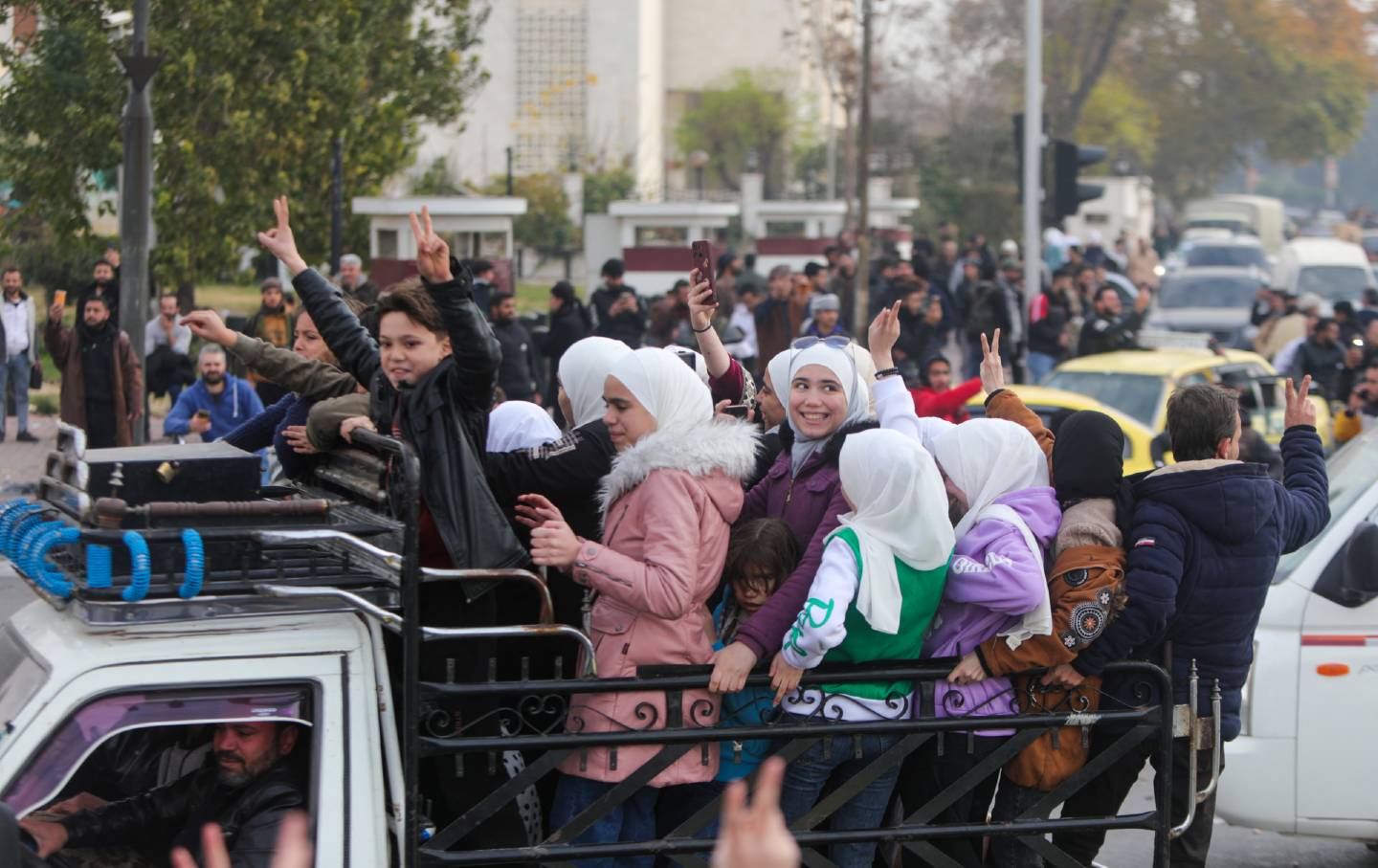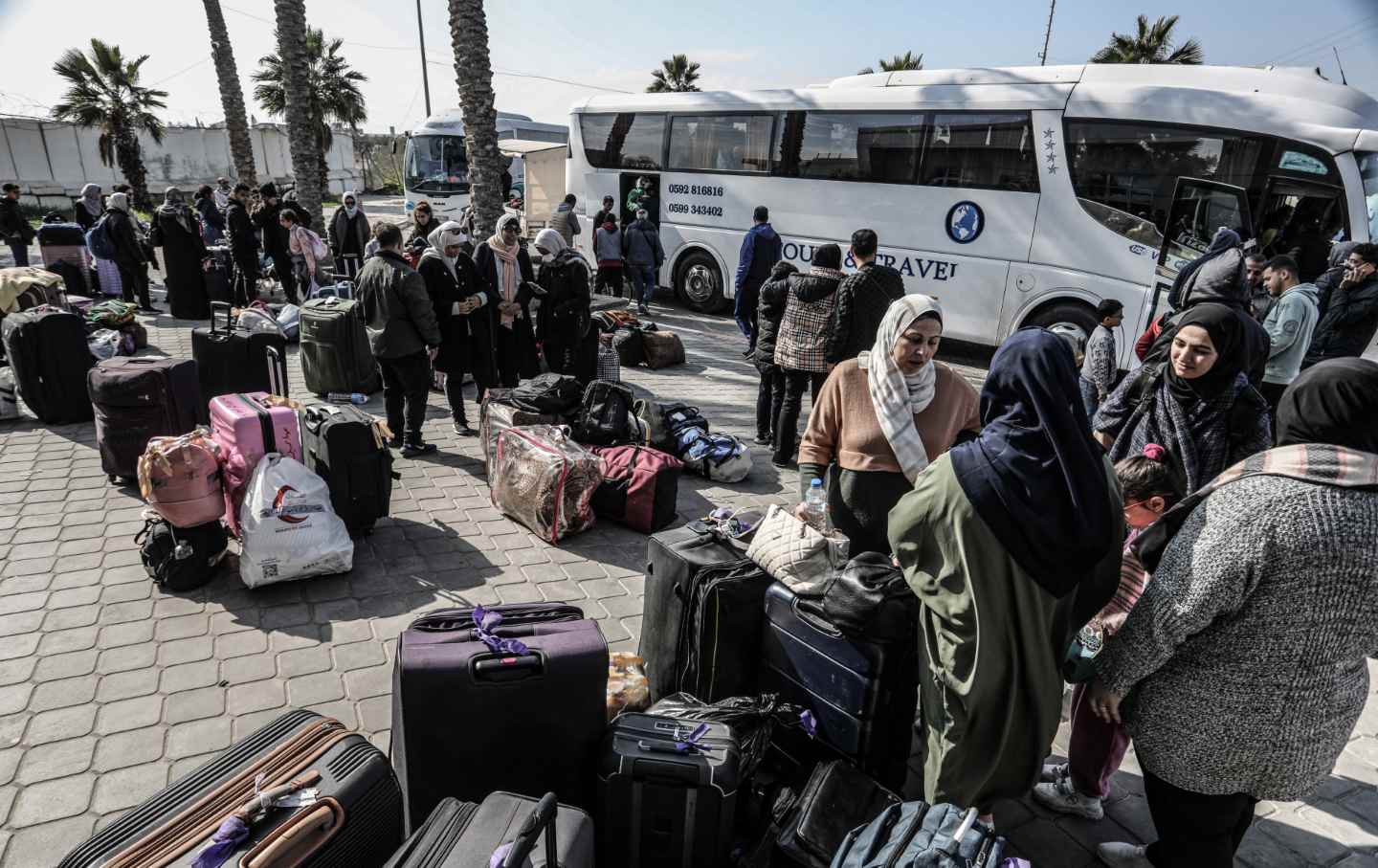In Search of Home
The double movement of Central and North American migration.
The Brutal Cycle of US Immigration Policy
In Everyone Who Is Gone Is Here, Jonathan Blitzer examines how North and Central American migration moves in two directions.

Dr. Juan Romagoza at La Clinica del Pueblo in 1998.
(Photo by Dayna Smith / Getty)Eddie Anzora arrived in El Salvador, the country of his birth, on the eve of its independence day. He had spent virtually his entire life in California, and his return was not a homecoming but an exile. A minor conviction for drug possession in 1997 had put Eddie on track for deportation, even though he had a green card. After a decade of dodging immigration officers, he was arrested on his way to the barbershop. He spent nine months in a Los Angeles County jail mentally preparing himself for a return to a country he hardly knew, until one day he and 30 other Salvadorans—all shackled at the wrists and ankles—were loaded onto a plane bound for San Salvador.
Books in review
Everyone Who Is Gone Is Here: The United States, Central America, and the Making of a Crisis
Buy this bookThe circumstances of Eddie’s deportation were the product of arcane laws drafted thousands of miles away by politicians who, if they thought of people like Eddie at all, regarded them as collateral damage at best and subhuman at worst. The year before his arrest, Congress had passed—and Bill Clinton had eagerly signed into law—legislation that gave immigration officers a mandate to deport noncitizens convicted of certain crimes. It didn’t matter that Eddie wasn’t in a gang (in fact, he had joined a “gang-skeptic” group called Above the Rest), that the cops had decided to stop him without a legal pretext, or that he had been found with a negligible amount of weed on him. The arrest branded him a “criminal alien” and thus a priority for deportation.
“Politics,” Jonathan Blitzer writes in Everyone Who Is Gone Is Here, his new book on the origins of today’s border crisis, “is a form of selective amnesia,” but “the people who survive it are our insurance against forgetting.” Eddie is one of those survivors and one form of this insurance. Like the other migrants highlighted in Blitzer’s book, he finds himself caught up in the cruel and crushing bureaucracy that is the US immigration system. He also proves far luckier than others ensnared in this web: Within a month of arriving in El Salvador, Eddie gets hired at a call center, where he works alongside other deportees. A perpetual hustler, he eventually opens a language school to train a new generation of call-center staffers. His pitch to prospective students: Learn English from a native speaker. But as Blitzer is careful to point out, most of the others that Eddie returned with fared far worse: “Of the thirty people on his original deportation flight, fewer than five were still alive.”
Blitzer’s book is a study of migration moving in two directions. While thousands of Salvadorans living in the United States are, like Eddie, forced onto deportation flights, thousands of others in El Salvador find themselves pushed out of their homes and forced to leave the country as a result of increasing gang violence and the fallout of decades of US-backed Cold War counterinsurgency programs. Between 2007 and 2015, the number of people who emigrated to the United States from Central America’s so-called Northern Triangle (El Salvador, Guatemala, and Honduras) rose by 25 percent. Blitzer painstakingly recounts the brutal circumstances behind this mass exodus, emphasizing the humanity of the people who uprooted their lives in search of safety in the US, only to find themselves criminalized in the very country they hoped would be their refuge.
Each person’s calculus for leaving is different. Some, Blitzer notes, are escaping torture, others poverty; in almost all cases, they have no legal channel through which to migrate. Keldy, a Honduran mother of three, goes to Denver with her husband in 2007 in search of work. “Although they never planned to stay in the U.S. for long,” Blitzer writes, “they risked everything to get there.” The trip is not easy. In Mexico, aboard the perilous freight train that migrants call “the Beast,” Keldy’s husband ties her to one of the cars so she doesn’t fall off. Later they’re kidnapped by Los Zetas, one of Mexico’s most notorious criminal syndicates. In Denver, their perilous journey gives way to the monotony of wage work: Keldy prepares and sells food, her husband paints houses, and they save up enough money to build a home in Honduras, where they return in 2010. “Neither of them expected to visit the U.S. ever again,” Blitzer writes.
But Keldy and her husband’s homecoming is marred by tragedy. Keldy’s family is threatened by armed men in Honduras who know she went north for work and assume that she came back wealthy. Several of her brothers are killed as a result. After two years of endless harassment and violence, Keldy and her husband flee with their sons, first to a small town in the forest and then—after Keldy testifies in court against one of the killers—to northern Mexico, where, armed with “a sheaf of documents held together with rubber bands,” Keldy and her two youngest boys cross the border into the US to ask for asylum.
What happens next will sound familiar to anyone who was paying attention to immigration policy at the height of the Trump era: Keldy is taken into custody and prosecuted for crossing the border illegally, and her sons are sent to a shelter for unaccompanied migrant kids. The boys, ages 13 and 15, are among the more than 5,600 children separated from their parents at the border under the Trump administration’s zero-tolerance policy. In an Immigration and Customs Enforcement detention center, Keldy meets other despondent women who faced a similar fate, and she compiles their names on a list that she hands to an immigrant-rights activist in the hope that she might help them. Meanwhile, an indifferent judge denies Keldy’s asylum claim, and while awaiting an appeal, she is tricked into signing a deportation order. Her sons are not sent back with her; they remain in the United States, living with an aunt in Philadelphia.
Trump’s border policies appear late in the book. But that is because the policies that preceded his—including those implemented under Barack Obama during his two terms as president—were also predicated on a logic of rounding up unauthorized immigrants in the interior of the country and preventing those at the border from getting any farther. Though Blitzer doesn’t make this argument explicit, he clearly wants to remind readers that the Trump administration’s cruelty was not an aberration or a break from precedent. Rather, it was the culmination of nearly half a century of bipartisan hostility toward migrants and the United States’ ruinous foreign-policy decisions in Central and South America. As Blitzer illustrates, the forces driving migrants from their homes are stronger than those giving them a good reason to stay.
Blitzer has a magazine writer’s keen attention to detail, and while the larger policy decisions of the United States are never far from the book’s narrative, he also turns his readers’ attention to the people whose lives are affected by them. His aim, he tells us, is “to be a kind of go-between: to tell each side’s story to the other” and to allow migrants “to participate, for once, in the privileged backroom conversations that decide their fate.”
Shifting his book’s narrative back in time to the 1960s, Blitzer takes us to the small Salvadoran city of Usulután and introduces us to Juan Romagoza, a 13-year-old who dreams of becoming a heart doctor. The El Salvador of Juan’s youth is no less dangerous than the country that Eddie Anzora returned to in 2007. The anti-communist military campaigns that occurred during Juan’s childhood and adolescence later gave way to gang violence, often committed with the weapons the US had sent to El Salvador during the Cold War. In the early years of Juan’s life, El Salvador was still contending with the fallout from the mass killings of suspected communists by government forces, which was referred to as La Matanza—“The Massacre.” By the time he was a teenager, El Salvador’s military had become brutally adept at eliminating communists and suspected communists. In 1980, a few weeks into his surgery residency, Juan operated on a student protester who had been shot by police. Hours later, security forces stormed the hospital to finish the job. Juan, who had been keeping vigil at the patient’s bedside, witnessed the murder. Less than a year later, while Juan conducted medical exams on campesinos in a rural hamlet, soldiers accused him of being a guerrilla and took him into custody, torturing him for weeks. Juan was eventually released, but thousands of others weren’t so lucky. More than 5,000 people were disappeared in the 12 years of El Salvador’s US-backed civil war, an estimated 75,000 others were killed, and nearly 1 million people fled the country. Among them was Juan, who was smuggled out of El Salvador in the back of a truck with two other men, hidden under bags of onions.
Juan settled in Mexico City, where he affected a Chiapas accent that he deployed in conversation like a shield. No longer able to pursue his dream of becoming a surgeon—one of his captors had mutilated Juan’s hands—he found work at a restaurant. On weekends, he headed north, to a clinic along the US-Mexican border, where he tended to US-bound Guatemalan refugees who had escaped their own country’s civil war. Though Juan would drive them to the fence dividing the United States and Mexico and deliver them to Arizona-based activists who helped them sneak across the border, he had no interest in crossing himself. It wasn’t fear that kept him from attempting it, but hope. Even though the border was far less policed at the time, Juan thought of his banishment to Mexico as temporary, and the farther he strayed from El Salvador, the more it felt like he was giving up on his prospects of ever returning.
Juan eventually entered the United States in 1983. With a physician’s sensibility, he reasoned that if he wanted to effect meaningful change, he should treat the disease rather than the symptoms. “If he traveled north,” Blitzer writes of Juan’s decision, “maybe there was some chance of doing something, however slight, that could pressure Washington to help wind down the conflict” in El Salvador. After all, the US government was funding the Salvadoran military’s human-rights abuses. Arriving in California, Juan became a community doctor of sorts and connected San Francisco’s growing undocumented population with free health services. He also held impromptu talk-therapy sessions for Salvadoran war refugees in Dolores Park. Unlike many of his compatriots, whose asylum claims were denied en masse—just 3 percent of Salvadoran asylum petitions were approved between 1980 and 1990—Juan was granted asylum in 1987. Green card in hand, he then moved to Washington, D.C.—“the capital of the empire that drove me from my home”—to run a community health clinic.
Juan’s trajectory is a best-case scenario, a rare example of the asylum system functioning as intended. His passage from El Salvador to the United States is an instance of a migrant finding not only refuge but prosperity in the US. Yet even Juan’s story is not a linear one. The past haunted him constantly. One day, at the clinic he ran in Washington, he was approached by a stranger who seemed to know a lot about him. “You were a prisoner. You were beaten and tortured,” the man told Juan. “I want to tell you that I was there. I saw what they were doing to you. I was part of it.” The man, it turned out, had been in the Salvadoran National Guard. He was conscripted, he explained, and had no choice. He was a torturer who was tortured by what he had done and who, like Juan, had escaped at the first possible opportunity. He wanted to tell Juan about all this—to unburden himself of the guilt, to explain the source of the demons that he, too, still reckoned with.
The encounter between torturer and victim may seem improbable, almost like something taken from a novel. But it was not an unusual experience in the tight-knit Central American enclaves that have developed across the United States. “At least a thousand war criminals from all over the world were living in the U.S. at the time, including many Salvadoran military officers,” Blitzer writes. “One war refugee bumped into his torturer on a public bus in the Bay Area. The man who had killed Oscar Romero”—the Catholic bishop who was gunned down in the middle of a mass for the high crime of opposing El Salvador’s repression of anyone who dared to help the poor—“sold used cars in Modesto, California.” Teenagers who had fled gang violence in San Salvador can find themselves sitting next to MS-13 members in classrooms on Long Island. Persecuted and persecutor alike wind up in the United States.
Popular
“swipe left below to view more authors”Swipe →In 2002, Juan had the opportunity to confront some of the more guilty parties in his own persecution: He testified against two Salvadoran generals, José Guillermo García and Carlos Eugenio Vides Casanova, the latter of whom had overseen his torture, as part of a landmark human-rights case. Vides Casanova maintained his steely demeanor as Juan recounted how he was beaten, mutilated, and starved by members of the National Guard. Juan, meanwhile, “had the sensation of leaving his body and floating above himself,” Blitzer writes. “He wasn’t alone. He was merging with the bodies of the people he knew, those who had died. The mother of his child. Romero. His friends. Family members…. Everyone who is gone is here.”
This powerful phrase, which Blitzer takes as the title of his book, is also the central message of Everyone Who Is Gone Is Here: What we often think of as a unidirectional cross-border movement of people from Central to North America actually flows both ways, as do the consequences of the human-rights crises that the United States has helped create. While Juan and many other Central Americans may see the ghosts of US power at home and encounter the demons they spent a lifetime running from even in the United States, these phantoms should haunt all Americans, too. Our lives are inextricably linked to those of people thousands of miles away, some of whom used to be our neighbors. As someone like Eddie Anzora knows all too well, sometimes the only way you can return home is as a disembodied voice, an interlocutor on the other end of a phone call.
More from The Nation

Celebrations in Syria May Be Premature Celebrations in Syria May Be Premature
The speed of the Assad dictatorship's collapse stunned even the opposition. But the result is a power vacuum that Israel and Turkey have already moved to occupy.

The Fall of Syria Changes Everything The Fall of Syria Changes Everything
Retired diplomat Chas Freeman and writer Pascal Lottaz discuss what happens now that Damascus is in the hands of Hayat Tahrir al-Sham.

Netanyahu Must Be Brought to Justice. But We Can’t Stop There. Netanyahu Must Be Brought to Justice. But We Can’t Stop There.
This genocide is a massive criminal undertaking, and we must hold as many of its perpetrators accountable as we can.

My Brother, Chef Mahmoud Almadhoun, Died Because He Fed Gaza’s Starving Citizens My Brother, Chef Mahmoud Almadhoun, Died Because He Fed Gaza’s Starving Citizens
His killing by Israel sent a chilling message that no one is safe, including humanitarians who stand in the way of Gaza’s erasure.

The Underground Network Helping Gazan Refugees Survive in Egypt The Underground Network Helping Gazan Refugees Survive in Egypt
A patchwork of volunteer-run mutual aid organizations has sprung up to tackle the severe problems facing people fleeing genocide.

The Dangers of Trump’s Foreign Policy The Dangers of Trump’s Foreign Policy
Strategic incoherence and factionalism reign.


